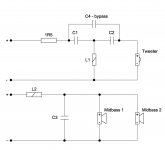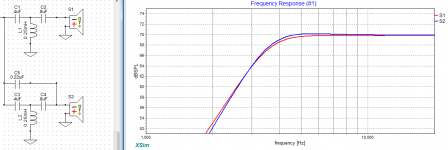Here's just a little thought experiment to follow up my last post. I wanted to look at how the Scan 2604 behaved with xo parts in front of it vs the Satori 29R. Don't take any of the xo values to be correct nor the position of the resistor either - the FR files also don't include baffle diffraction effects and I just randomly chose a low roll-off frequency that might be suitable with an MTM design or not.
So here is the Scan 2604 again from Zaph (grey) vs the Satori 29R again from the spec sheet (blue) when you just drop it in with no xo changes:

Fairly similar below about 3.8Khz but significantly different above that.
And here are the 2 again but this time with just some minor tweaks to the xo values:

Now we get pretty much a perfect match except for the boost in between about 8.5Khz and 16Khz which again may be exactly the kind of thing that will make the difference you are looking for.
And the xo schematic:

I chose a simple 3rd order electrical with a 1.5ohm resistor before it. S2 is the Satori with no xo changes and S3 shows the changes that were made. The situation could be a little different given the original actual xo parts used on the tweeter, but it certainly shows possibility anyways.
Physical dimensions look similar too except for slightly different Satori wire terminal positions which shouldn't be too hard to change.
So here is the Scan 2604 again from Zaph (grey) vs the Satori 29R again from the spec sheet (blue) when you just drop it in with no xo changes:
Fairly similar below about 3.8Khz but significantly different above that.
And here are the 2 again but this time with just some minor tweaks to the xo values:
Now we get pretty much a perfect match except for the boost in between about 8.5Khz and 16Khz which again may be exactly the kind of thing that will make the difference you are looking for.
And the xo schematic:
I chose a simple 3rd order electrical with a 1.5ohm resistor before it. S2 is the Satori with no xo changes and S3 shows the changes that were made. The situation could be a little different given the original actual xo parts used on the tweeter, but it certainly shows possibility anyways.
Physical dimensions look similar too except for slightly different Satori wire terminal positions which shouldn't be too hard to change.
Looking at the picture of the pcb, I surmise the problem could be solved with keeping the unit but swap the passive parts. So the caps are marked Proac, surely local OEM at seing expotus resistor and Alcap cap (that should be measured if the speaker is less than 10 yo to have the value for futur refurbishment.
If Clarity cap, they are a little dark sound...sparkle are often missing with them according the xo. Expotus could be also changed for something bringing more ligth if it is for the tweeter atenuation, like a Mundorf M resist Sup.
This Scan Speak tweeter is not bad after all. And if a Solen for the caps, well it is worthing the change too.
I would invest filter values rework or tweeter swap only after...
My two cents.
If Clarity cap, they are a little dark sound...sparkle are often missing with them according the xo. Expotus could be also changed for something bringing more ligth if it is for the tweeter atenuation, like a Mundorf M resist Sup.
This Scan Speak tweeter is not bad after all. And if a Solen for the caps, well it is worthing the change too.
I would invest filter values rework or tweeter swap only after...
My two cents.
We still don't know, has 1R5 been tested over 1R5 in parallel and what is the result? I think it's pretty easy to perform.
i will remove the xo this weekend to see what its really about and all the values.
i super appreciate all the feedback!
because I suspect from measurements that one speaker is slightly louder than the other because of that
Measure both resistors, but I doubt that's the reason. Then measure the bipolar electrolytic capacitors, which is the most suspicious. Third, replace the tweeters with each other, they are usually not exactly the same. Like other drivers, if they are not paired there is always a little difference, it is rarely heard but it is not impossible. All these dilemmas are solved by one measurement of the frequency range, whereby both speakers must be measured in the same place in the room. Rom gain varies greatly in different locations in the room.
Notice you have to measure each capacitor bt lifting one leg on the pcb. Measurement is mandatory both because the caps could be sorted out for a precise value'or at the opposite if you see there is only 10% or more precision with the body marking. The lythic cap value may be more than 20% ...i will remove the xo this weekend to see what its really about and all the values.
i super appreciate all the feedback!
How do you like the Clarity Cap CSA, which is also not that expensive?As for capacitors, my favorites are ClarityCapSA. They sound great and are not expensive.
I like the CSA more than SA, and have some CMR to try.
Since you like the SA so much, try the ASC X386 or X387 caps. I waffled a while between them, and the ASC won out in the end.
Since you like the SA so much, try the ASC X386 or X387 caps. I waffled a while between them, and the ASC won out in the end.
I also wanted to ask, what happens when the speakers change places left and right? Is the same speaker still a little louder? Maybe the problem is in the volume potentiometer? They can have several dB differences left-right.
For more sparkle, I recommend Jantzen Silver Z, although they are more expensive.
Of the cheaper ones, Mundorf EVO Oil is acceptable. Also Wima FKP10.
The choices are so great today, it’s easy to get lost.
Of the cheaper ones, Mundorf EVO Oil is acceptable. Also Wima FKP10.
The choices are so great today, it’s easy to get lost.
The Evo oil is a little slow sounding subjectivly, rigth ? Imo either Jantzen Sup or silver will do according the budget.
Also before as cheap: try 0.1 uF from Panasonic ECW-FE. This one has ligth and sparkle.
Also before as cheap: try 0.1 uF from Panasonic ECW-FE. This one has ligth and sparkle.
It all depends on the price you want to pay for capacitors, mostly the more expensive ones are better, although there are exceptions. I can say that the bypass cap helps, but it doesn't work wonders if the primary capacitor is bad. I use slightly higher values for bypass, I put 0.22uF on the tweeters, for midrange and bass I put even higher values.
That is more than just bypassing, and actually increases the rolloff slope rate at xover.
In this instance, it will do quite a bit, and more than just bypassing.
if done as bypass in the traditional sense, it does not really do much except trim value.
In this instance, it will do quite a bit, and more than just bypassing.
if done as bypass in the traditional sense, it does not really do much except trim value.
The 0.22uF capacitor at 3kHz has an impedance of 241ohm. This does not significantly affect the cutting frequency in any way.
- Home
- Loudspeakers
- Multi-Way
- 'Upgrading’ my tweeters (can I do this?)

